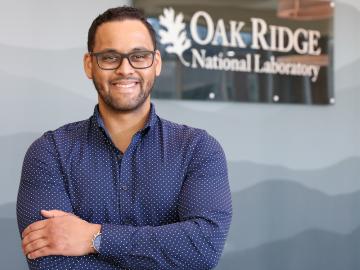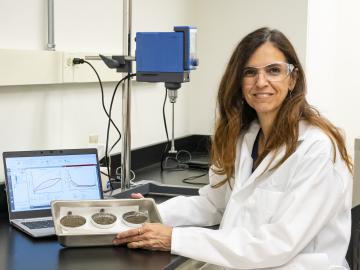
Filter News
Area of Research
- Advanced Manufacturing (8)
- Biology and Environment (7)
- Energy Science (25)
- Fusion and Fission (1)
- Fusion Energy (2)
- Isotopes (1)
- Materials (44)
- Materials for Computing (9)
- Neutron Science (5)
- Nuclear Science and Technology (4)
- Quantum information Science (1)
- Supercomputing (3)
- Transportation Systems (1)
News Type
News Topics
- (-) Materials (45)
- (-) Materials Science (49)
- (-) Mercury (7)
- (-) Molten Salt (5)
- (-) Physics (20)
- 3-D Printing/Advanced Manufacturing (47)
- Advanced Reactors (15)
- Artificial Intelligence (25)
- Big Data (29)
- Bioenergy (40)
- Biology (48)
- Biomedical (24)
- Biotechnology (11)
- Buildings (31)
- Chemical Sciences (22)
- Clean Water (21)
- Composites (14)
- Computer Science (56)
- Coronavirus (17)
- Critical Materials (14)
- Cybersecurity (9)
- Emergency (1)
- Energy Storage (45)
- Environment (88)
- Exascale Computing (4)
- Fossil Energy (1)
- Frontier (4)
- Fusion (18)
- Grid (29)
- High-Performance Computing (23)
- Hydropower (8)
- Irradiation (2)
- Isotopes (18)
- ITER (4)
- Machine Learning (24)
- Mathematics (8)
- Microscopy (22)
- Nanotechnology (18)
- National Security (20)
- Neutron Science (37)
- Nuclear Energy (35)
- Partnerships (4)
- Polymers (15)
- Quantum Computing (6)
- Quantum Science (17)
- Security (8)
- Simulation (17)
- Space Exploration (10)
- Statistics (1)
- Summit (10)
- Transportation (48)
Media Contacts

When Addis Fuhr was growing up in Bakersfield, California, he enjoyed visiting the mall to gaze at crystals and rocks in the gem store.

ORNL researchers have identified a mechanism in a 3D-printed alloy – termed “load shuffling” — that could enable the design of better-performing lightweight materials for vehicles.

Oak Ridge National Laboratory researchers serendipitously discovered when they automated the beam of an electron microscope to precisely drill holes in the atomically thin lattice of graphene, the drilled holes closed up.

Oak Ridge National Laboratory scientists designed a recyclable polymer for carbon-fiber composites to enable circular manufacturing of parts that boost energy efficiency in automotive, wind power and aerospace applications.

Materials scientist Denise Antunes da Silva researches ways to reduce concrete’s embodied carbon in the Sustainable Building Materials Laboratory at ORNL, a research space dedicated to studying environmentally friendly building materials. Credit: ORNL, U.S. Dept. of Energy

Gang Seob “GS” Jung has known from the time he was in middle school that he was interested in science.

Researchers at ORNL explored radium’s chemistry to advance cancer treatments using ionizing radiation.

Researchers from ORNL, the University of Tennessee at Chattanooga and Tuskegee University used mathematics to predict which areas of the SARS-CoV-2 spike protein are most likely to mutate.

Oak Ridge National Laboratory physicist Elizabeth “Libby” Johnson (1921-1996), one of the world’s first nuclear reactor operators, standardized the field of criticality safety with peers from ORNL and Los Alamos National Laboratory.

Researchers at Oak Ridge National Laboratory and Momentum Technologies have piloted an industrial-scale process for recycling valuable materials in the millions of tons of e-waste generated annually in the United States.


